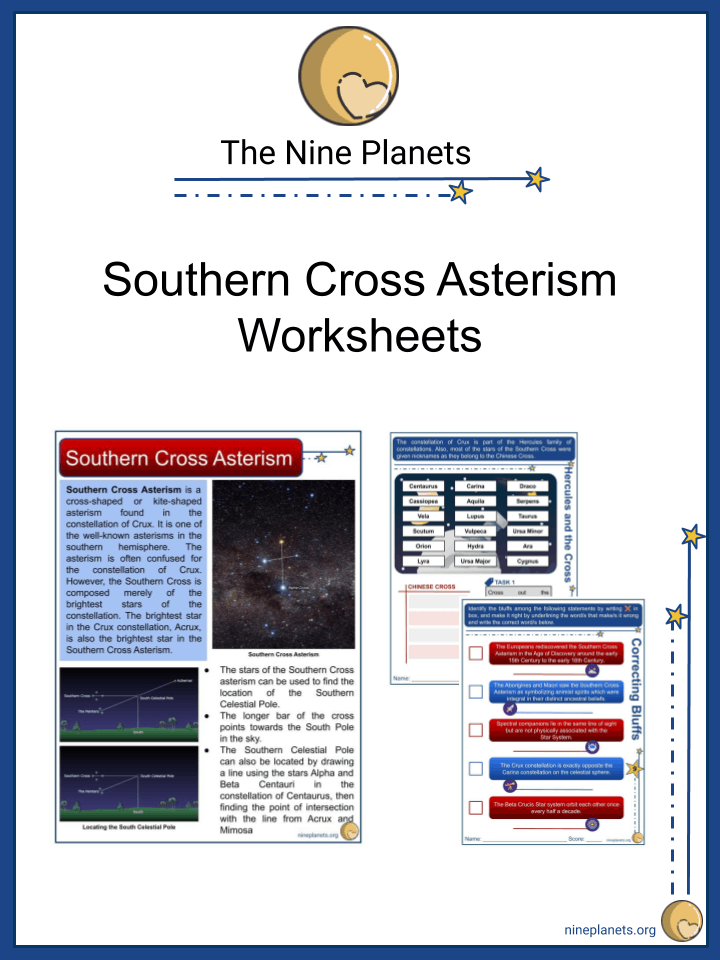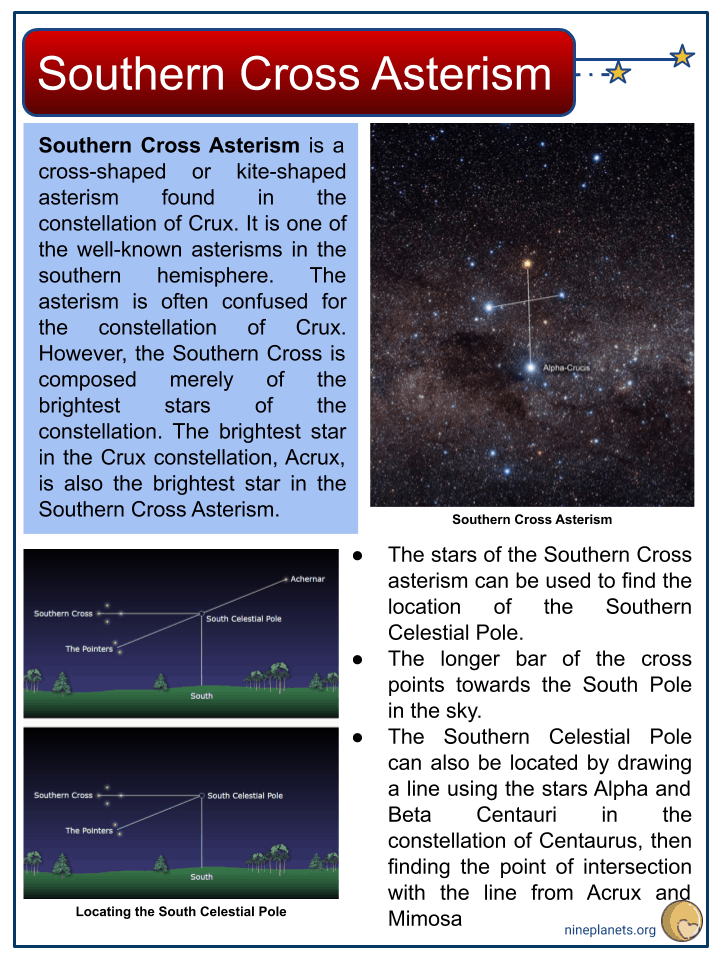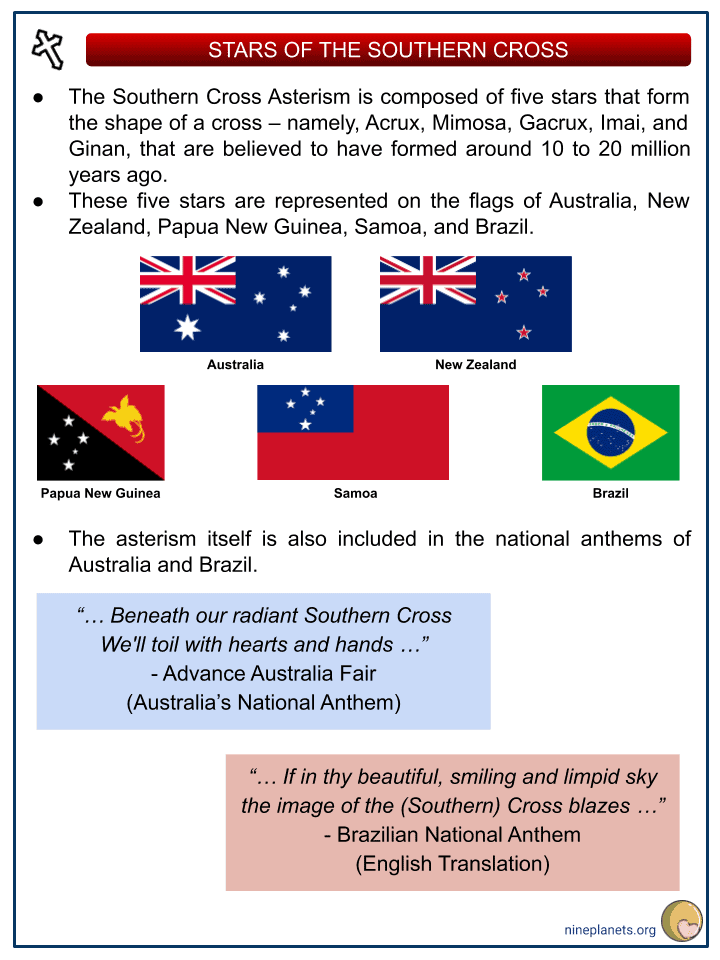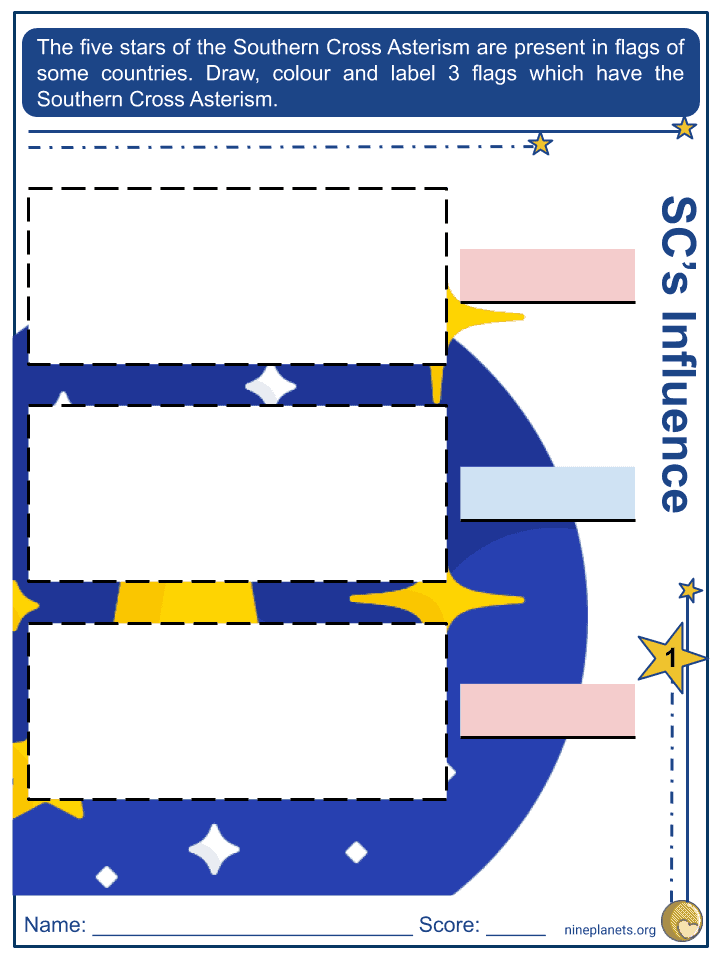Download Southern Cross Worksheets
Click the button below to get instant access to these premium worksheets for use in the classroom or at a home.

This worksheet can be edited by Premium members using the free Google Slides online software. Click the Edit button above to get started.
Download free sample
Not ready to purchase a subscription yet? Click here to download a FREE sample of this worksheet pack.
Resource Examples
Click any of the example images below to view a larger version.




Key Facts & Information
- Southern Cross Asterism is a cross-shaped or kite-shaped asterism found in the constellation of Crux. It is one of the well-known asterisms in the southern hemisphere. The asterism is often confused for the constellation of Crux. However, the Southern Cross is composed merely of the brightest stars of the constellation. The brightest star in the Crux constellation, Acrux, is also the brightest star in the Southern Cross Asterism.
- The stars of the Southern Cross asterism can be used to find the location of the Southern Celestial Pole.
- The longer bar of the cross points towards the South Pole in the sky.
- The Southern Celestial Pole can also be located by drawing a line using the stars Alpha and Beta Centauri in the constellation of Centaurus, then finding the point of intersection with the line from Acrux and Mimosa
Stars Of The Southern Cross
- The Southern Cross Asterism is composed of five stars that form the shape of a cross – namely, Acrux, Mimosa, Gacrux, Imai, and Ginan, that are believed to have formed around 10 to 20 million years ago.
- These five stars are represented on the flags of Australia, New Zealand, Papua New Guinea, Samoa, and Brazil.
- The asterism itself is also included in the national anthems of Australia and Brazil.
- The Alpha, Beta, and Delta Crucis are co-moving members of the Scorpius-Centaurus Association, which is an association of stars in the Scorpius and Centaurus Constellation that belong to the spectral classes O and B, have a common proper motion, and are believed to have formed within the same giant molecular cloud.
Acrux
- Acrux or Alpha Crucis is the brightest star in the Crux constellation, and the 13th or 12th brightest star in the sky, due to its variability in brightness.
- Acrux is actually a multiple star system with six components.
- The two visually distinguishable components are both hot class B stars and are on the verge of becoming class O.
- The primary star, Acrux Aa, is 25,000 times brighter than our Sun while the secondary star, Acrux Ab, is 16,000 times brighter.
- Acrux A has an estimated mass of about 17.8 solar masses and a radius of 7.8 solar radius.
- The primary star is of spectral type B0.5IV.
- Acrux B, on the other hand, has a mass of about 15.52 solar masses and a radius of 5.4 solar radius.
- The secondary star is of spectral type B1 V.
- Both stars are much hotter than the sun, with surface temperatures of 24,000 K and 28,000 K, respectively.
- In Chinese, Acrux is known as the Second Star of Cross, wherein Cross is a Chinese asterism that consists of Acrux, Mimosa, Gacrux, and Delta Crucis.
- In Portuguese, Acrux is known as the Star of Magellan.
Mimosa
- Mimosa, also designated as Beta Crucis and also known as Becrux, is the second-brightest star in the Crux constellation, and the 20th brightest star in the night sky.
- Beta Crucis is 34,000 times brighter than our Sun and is suggested to be around 8 to 11 million years old.
- Mimosa is thought to be the hottest first magnitude star and is classified as a Beta Cephei Variable with three different pulsation periods.
- Becrux is a binary star and is suspected to be actually a triple star system.
- The primary star, Mimosa A, is about 16 times more massive than the sun while the secondary star, Mimosa B, is 10 times more massive.
- Mimosa A has an estimated radius of about 8.4 solar radius and an estimated surface temperature of around 27,000 K.
- Mimosa A is of spectral type B0.5 III and Mimosa B is of spectral type B2V.
- The stars orbit each other once every half a decade.
- A third companion was discovered in 2007, which is speculated to be a pre-main sequence star, and there are other two stars nearby that are suggested to be optical companions, in which they lie in the same line of sight but are not physically associated with the Beta Crucis system.
- In Chinese, Mimosa is known as the Third Star of Cross, in line with Acrux.
Gacrux
- Gacrux or Gamma Crucis, is the nearest M-class giant star to the sun.
- Gamma Crucis is the third brightest star in the Crux constellation, and the 25th brightest star in the night sky.
- The star is of spectral type M3.5 III.
- Gacrux is around 758 times brighter than the Sun and has a surface temperature of 3,689 K.
- It has an estimated mass of about 1.5 solar masses and a radius of around 120 solar radii.
- In Chinese, Gacrux is known as the First Star of Cross, in line with Acrux and Becrux.
- Portuguese-speaking people in Brazil call the star Rubídea, meaning Ruby-like, due to its colour.
Imai
- Imai or Delta Crucis is the 4th brightest star in the Crux constellation and the faintest in the most prominent stars of the constellation.
- The star is of spectral type B2 IV, it is a hot, massive blue-white subgiant star which is currently in the process of becoming a red giant.
- Delta Crucis is around 10,000 times brighter than our Sun and has an estimated surface temperature of 22,570 K.
- It has an estimated mass of 8.9 solar masses and a radius of around 8 solar radii.
- Like Mimosa, Imai is believed to be a Beta-Cephei variable.
- Imai is sometimes known as Pálida in Portuguese, which means “the pale one”.
Ginan
- Ginan, also designated as Epsilon Crucis, is the 5th brightest star in the constellation of Crux.
- The star is of spectral type K3 III.
- Epsilon Crucis is 302 times brighter than our Sun and has a surface temperature of 4,294 K.
- It has a mass of around 1.52 solar masses and a radius of 28.42 solar radii.
- Ginan is evolving away from the main sequence and thus will continue to expand.
- It is also known as Intrometida in Portuguese, which means “the intrusive one”.
The Crux
- The Southern Cross Asterism is located at the constellation of Crux, the smallest among the 88 modern constellations, that covers around 68 square degrees in the sky.
- The Crux constellation is not visible north of 20 degrees in the northern hemisphere, and is circumpolar south of 34 degrees in the southern hemisphere, which means that it never sets below the horizon.
- Crux is exactly opposite the Cassiopeia constellation on the celestial sphere.
- The constellation of Crux is part of the Hercules family of constellations, together with Aquila, Ara, Centaurus, Corona Australis, Corvus, Crater, Cygnus, Hercules, Hydra, Lupus, Lyra, Ophiuchus, Sagitta, Scutum, Sextans, Serpens, Triangulum Australe, and Vulpeca.
False Cross
- Most observers confuse the Southern Cross Asterism with the so-called False Cross, which is formed by the four other bright stars in the vicinity.
- The x-shaped false cross resembles the Southern Cross asterism and is orientated in almost the same way.
- The four stars that form this so-called false cross are: two stars from the Carina constellation, Aspidiske (Iota Carinae) and Avior (Epsilon Carinae), and two stars form the Vela constellation, Kappa Velorum and Delta Velorum.
- These stars are located a little farther to the north and do not point to the Southern Celestial Pole.
- However, they will eventually point towards the pole around the year 8600, when the pole has gradually shifted.
Did You Know?
- The Southern Cross Asterism was an important symbol for the Egyptians, in which it represented the place where the Sun-goddess, Horus, was crucified.
- The Aborigines and Maori saw the Southern Cross Asterism as symbolizing animist spirits which were integral in their distinct ancestral beliefs.
- A depiction of the Southern Cross Asterism was discovered on a stone engraving found on Machu Picchu.
- The Incas knew the asterism as “Chakana” which means stair, and played an important part in the Incan mysticism, symbolizing the three tiers of the world: the heavens, the world of the living, and the underworld.
- The first documented discovery of the asterism was found in Ancient Greece in around 1000 BC.
- A 19th Century expert Richard Hinckley Allen noted that the stars of the Southern Cross Asterism were last visible on the horizon at Jerusalem around the same moment when Christ was crucified.
- The Europeans rediscovered the Southern Cross Asterism in the Age of Discovery around the early 15th Century to the early 17th Century.
- Amerigo Vespucci is believed to be the first European to see those (what he called) “four stars” during his third voyage in 1501.